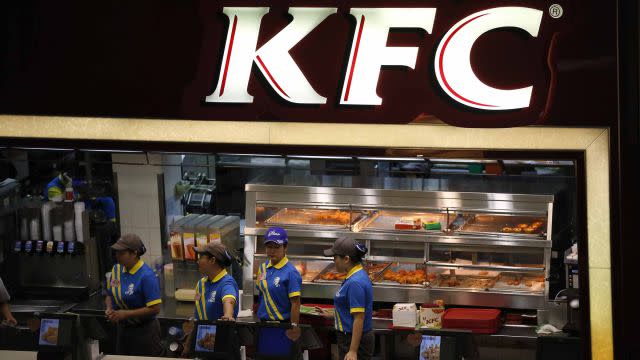KFC is failing in China because its fast food is way too slow

I recently met two friends at a near-deserted KFC outlet in Chongqing, a city in China’s southwest. I initially assumed they had already finished eating when I joined them, as there was no food on their table. But minutes later, a member of staff arrived with their meals; two Peking Duck wraps, two fries, and two Pepsis. They’d waited 10 minutes for their food because the kitchen didn’t have anything ready when they arrived.
I ordered the same thing, and was told it would be another 10 minute wait. Apparently, the kitchen hadn’t made a new batch after they ran out earlier. They had also run out of fries, but, hey, at least mine would be hot.
KFC has struggled mightily in China, as has its parent company Yum! Brands, which owns Pizza Hut, Taco Bell, and several local Chinese brands. Last week, Yum’s share price plummeted after it reported that third-quarter same-store sales at its Chinese branches rose by just 2% from a year earlier—they were expected to increase by almost 10%. Yum cut its 2015 earnings forecast, and billions of dollars were wiped off the company’s market cap:

That’s because KFC’s China operations are crucial to Yum. The company describes KFC as the “largest restaurant chain in China,” and it makes up by far Yum’s biggest footprint there, with more than 4,800 outlets at the end of 2014.
In recent years, KFC’s China operations have certainly been troubled. KFC has been accused of everything from using illegal drugs to fatten their birds to having ice cubes that are dirtier than toilet water, to feeding customers out-of-date meat, while the avian flu scare spooked potential chicken eating customers entirely.
But KFC is hardly the only fast food chain to face these accusations: McDonalds and local chain Kung Fu were also singled out in the ice cube controversy, while McDonalds too was hit by the out-of-date meat scandal. Anyone who sells chicken faced falling sales from avian flu worries.
From my personal observation, KFC’s real problem in China is something more fundamental—they’re making slow food, not fast food.
Over the five years I’ve visited KFC during lunch time (not every day, I must add), when the lines could be as much as 10 people deep, but I’m often asked to take a seat because standard menu items—like two pieces of original recipe chicken—will need to be cooked from scratch. It’s not uncommon, in my experience, to find that around half the menu is entirely unavailable.
Somewhere between its Kentucky head office and the thousands of individual outlets in China, KFC lost the basic rules of fast food. It should be food that is served quickly, because it is prepared in advance, with military-level attention to supply, workflow, and demand. McDonalds in China is as efficient as it is anywhere in the world, so being in China has nothing to do with KFC’s problems.
When KFC first entered China in 1987, it was a special Western-style treat that customers would happily wait for, and the chain was initially so successful that became a case study for doing business in China. But in the years since, local competitors like Hua Lai Shi and Dico’s that also serve items like fried chicken legs and fries have sprung up, and are eating at its market share.
Yum Brands’ third-quarter results were so shocking that analysts are now calling for a major shake up. “Spin off China, sell stores, do something,” Howard Penney, an analyst at Hedgeye Risk Management, told Reuters.
Before it takes such radical and costly steps, KFC might want to go back to the basics, and make fast food again.
We welcome your comments at ideas@qz.com.

Sign up for the Quartz Daily Brief, our free daily newsletter with the world’s most important and interesting news.
More stories from Quartz:

